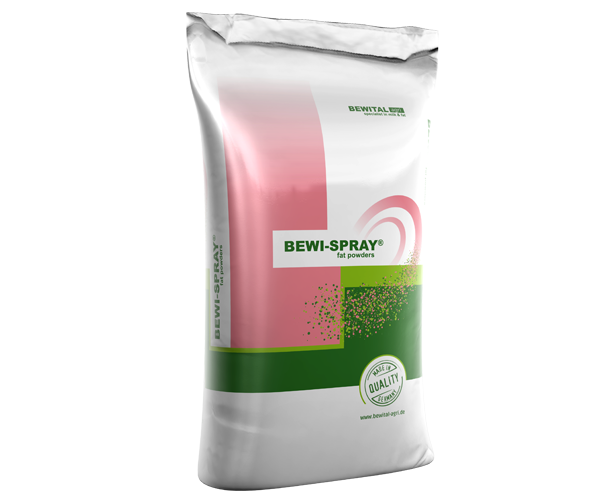Energy supply for high-yielding cows – Rumen-stable fats are the key to success
High-yielding dairy cows have an increased energy requirement, especially after giving birth. The first third of lactation in particular requires a great deal of attention. Appropriate feeding strategies can therefor support sustainable milk production. The use of rumen-stable fats has a positive effect on metabolic functions. The particle size of the fat powder is important for digestibility.
Dairy farms in Germany have been able to significantly increase the milk yield of their cows, particularly in recent years. Average herd yields of over 12,000 kg of milk per cow per year are not uncommon thanks to improved feeding, husbandry and care. Good farms endeavour to further in-crease milk yield, especially lifetime yield. Genetic selection has greatly increased the milk yield of cows. However, this did not simultaneously lead to a proportional increase in feed intake. Adjusting the energy and nutrient concentration in the ration often cannot cover the entire additional requirement for the higher milk yield. At the same time, health, metabolic and fertility problems have increased on many farms. These negative effects can be minimised through early monitoring and suitable feeding strategies, which contributes to the profitability and sustainability of milk production.
Immediately after the birth of the calf, the energy requirement of the dairy cow increases rapidly with the start of milk production. In the past, the increase in annual milk yield was mainly achieved by selecting for a higher initial milk yield (Brade, 2024). The limited feed intake capacity, especially at the beginning of lactation, leads to insufficient nutrient intake and thus to inadequate coverage of the increased energy requirements. This results in a negative energy balance (NEB), at least in the first third of lactation. This is mainly compensated for by fat mobilisation. The extent and duration of the NEB are primarily determined by the feed intake, the energy density of the ration and the realised milk yield. The increase in milk yield and feed intake at the beginning of lactation occurs with a time lag. NEB is a common phenomenon in high-yielding dairy cows, with negative effects on health, milk production and fertility. NEB, which is now considered a ‘health risk’, is not yet taken into account in the breeding process (Brade, 2024).
Negative energy balance leads to a decrease in the BCS values
The high-yielding cow tries to compensate for the NEB that occurs in the first third of lactation by mobilising the body’s own energy stores, especially body fat (lipolysis). The extent of this loss of body mass in early lactation has increased significantly in recent decades due to selection pressure on initial milk yield. Fluctuations in live weight have evolved in wild and domestic animals as an adaptation to fluctu-ations in energy requirements and energy supply.
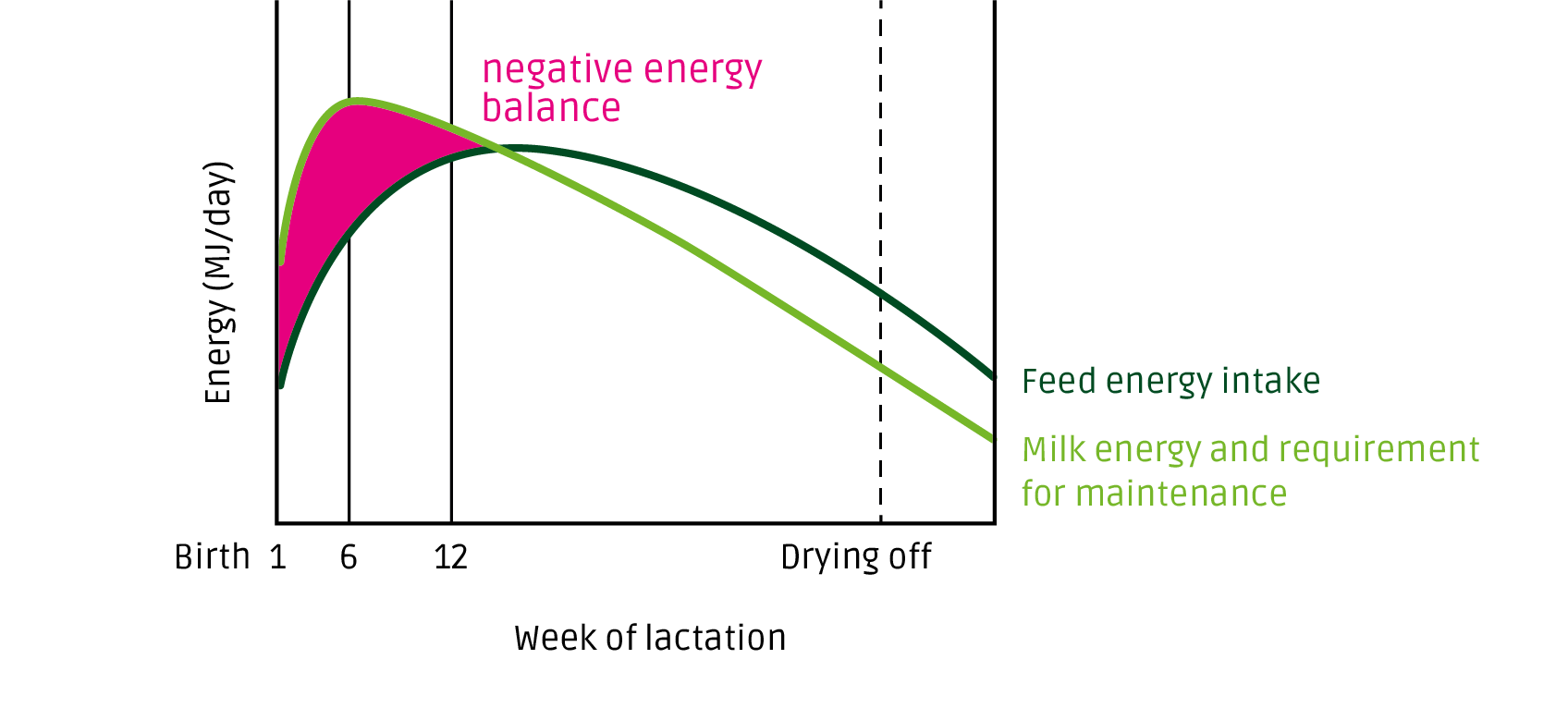
The dairy cow is a good example of this cycle. Many cows bred for high milk yield mobilise large amounts of body reserves in the first month of lactation. This can lead to a loss of more than 10 % of body weight. In late lactation, when the milk yield decreases, the body reserves are replenished. This can be documented by a regular body condition score (BCS).
Some cows consistently lose more body weight in the first month of lactation than others. This also appears to be genetically determined. The extent of body mass loss increases with increasing lactation number. It is also known that better body condition at the time of birth, defined by a higher body condition score (BCS), leads to significantly greater fat mobilisation and therefore greater weight loss in the first month of lactation. A greater decrease in the BCS value can be observed in these cows.
Fat mobilisation has effects on the immune system
Bradford and Contreras (2024) directly correlate the metabolic processes that occur in adipose tissue during dissolution/mobilisation with the development of immune cells in the adipose tissue. This is a sign of an inflammatory reaction. The T lymphocytes in particular, formerly known as T killer cells, do not completely regress during lactation, but are retained until the next birth. In the next phase of necessary lipolysis at the beginning of the following lactation, this leads to increased recruitment of immune cells and thus to an increased inflammatory reaction. In many cows, BCS fluctuations are known to increase with the number of lactations. In the fourth lactation, the number of immune cells may have reached a level at which the metabolic and immunological effects of the inflamed fatty tissue become visible. The cow’s resistance to the stresses associated with a high milk yield is then significantly reduced. This phenomenon could explain the increased risk of metabolic problems, infections or infertility in cows that show a greater NEB at the beginning of lactation and thus a greater decrease in body condition.
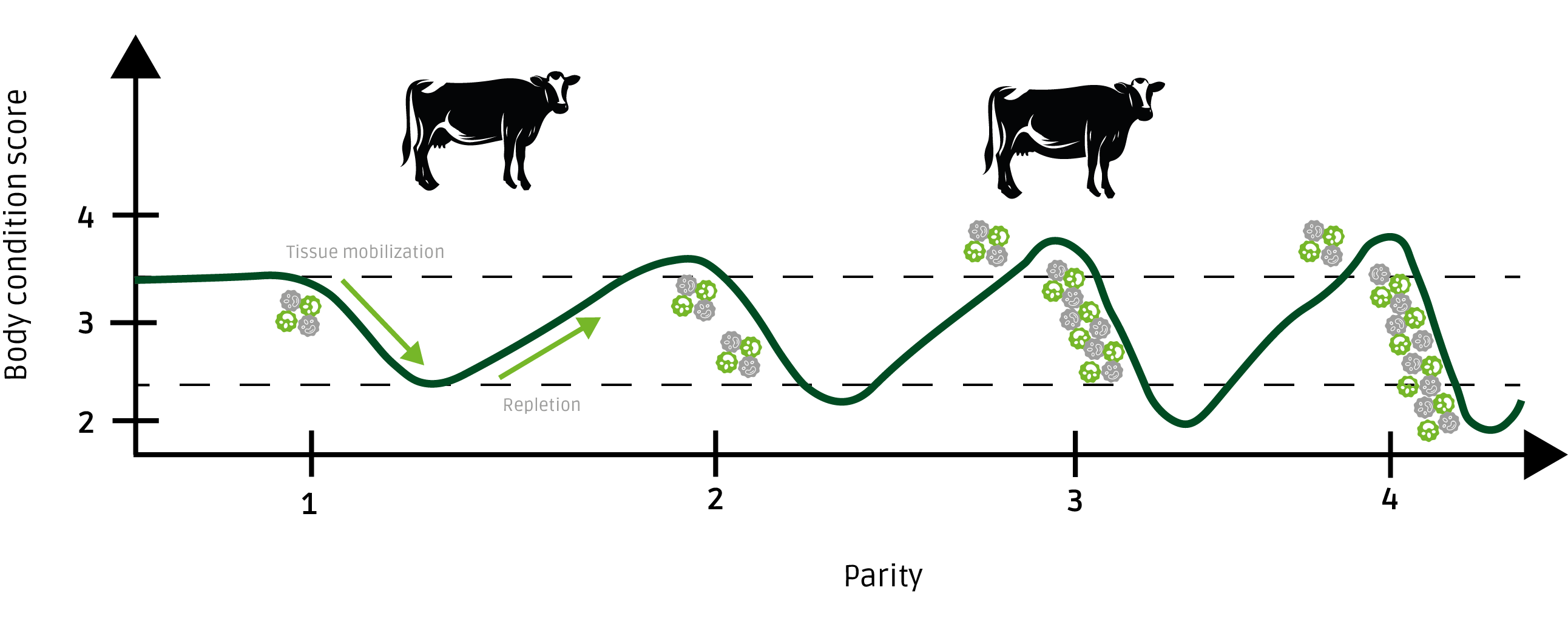
Rumen-stable fat to reduce NEB
The lifetime performance of dairy cows is of great importance for sustainable milk production. Care must therefore be taken to keep cows healthy over several lactations. The energy supply of the high-yielding cow in the first third of lactation requires special attention, as current summaries of international research show. Particularly in debilitating situations (e.g. heat stress) or phases of high performance (e.g. early lactation), it is important to ensure energy supply despite reduced feed intake without placing a strain on rumen function. Increased use of high-starch concentrates available in the rumen can lead to impairment of rumen function (acidosis). Due to their high energy content, fats are particularly interesting for the energetic valorisation of rations. The use of rumen stable fats does not impair microbial digestion in the rumen. These fats are not metabolised in the rumen and enter the abomasum unchanged. Rumen-stable fats are only digested in the small intestine. When using rumen-stable fats, however, it is important to know their special properties. Rumen-stable fats are primarily based on palm or rapeseed oil. The products made from these differ significantly in their fatty acid pattern. The decisive factor is the proportion of palmitic acid (C16:0) or stearic acid (C18:0). Palmitic acid (C16:0) and stearic acid (C18:0) differ in their effect on the dairy cow’s metabolism. There are also differences in terms of lactation stage and performance level.
Palmitic acid – lipogenic fatty acid
As a lipogenic fatty acid, palmitic acid is mainly used to build up milk or body fat. Its use for the build-up of milk fat is limited in terms of quantity. Under the conditions of a negative energy balance, this leads to an accumulation in liver fat, as in this phase there is no build-up but rather a mobilisation of body fat. In a study by de Souza et al. (2019), the effects of using products rich in palmitic acid (>80 % C16:0) with a proportion of 1.5 % C16:0 in the total dry matter of the ration on milk fat production and milk quantity were investigated. An increase in milk fat production was observed, but no influence on milk yield. The cows that received palmitic acid at the beginning of lactation even lost more body weight and had higher NEFA values in their blood. This shows that there is an increase in the negative energy balance at the beginning of lactation. This could also explain the repeatedly described negative effects of prolonged high use of palmitic acid-rich products in the first half of lactation. In contrast, the use of a mixture of palmitic acid and stearic acid (46 % stearic acid) with a proportion of 2 % in the DM in Piantoni et al. (2015) led to an improvement in energy intake, a reduction in the negative energy balance and a reduction in body mass losses at the beginning of lactation. This shows the need to limit the palmitic acid content in the feed at the beginning of lactation. Products rich in palmitic acid (> 80 % C16:0) should only be used to a limited extent or not at all in early lactation in order to avoid a negative influence on the metabolism.
Stearic acid provides energy for the metabolism
In contrast to palmitic acid, stearic acid can be metabolised significantly better in the liver for energy production even before the calf is born and in early lactation (Loften et al., 2014). In Piantoni et al. (2015), the use of a product rich in stearic acid (>90 % C18:0) with 2 % in the dry matter resulted in increased dry matter intake (26.1 kg/day vs. 25.2 kg/day) and milk yield (40.2 kg/day vs. 38.2 kg/day). The concentration of milk constituents remained unchanged, but an increase in the daily milk fat and milk protein content was observed. The increase in dry matter intake and milk yield was even greater in high-producing cows (>50 kg/day) than in low-producing cows (<40 kg/day). In the study by Daneshvar et al. (2021), an increase in milk production and dry matter intake was observed with a stearic acid-rich fat supplement (75 % stearic acid), especially with a starch-rich ration (26 % starch/kg DM), compared to a palmitic acid-rich fat supplement (80 % palmitic acid). An important function of stearic acid in the metabolism of high-yielding cows at the beginning of lactation is described as a ‘glucose-saving mechanism’. In phases of negative energy balance, stearic acid shifts energy in the direction of new glucose production.
In studies by Karcagi et al. (2010) and in other studies, a significant reduction in the reduction in blood glucose levels that typically occurs at the start of lactation was observed through the use of rumen-stable fat powders containing stearic acid.
Combination of stearic acid and palmitic acid is optimal
In their summary, Loften et al. (2014) already describe the advantages of a combination of stearic acid and palmitic acid in rumen-stable fat as an energy source for high-yielding cows. This is confirmed by more recent research (Shepardson and Harvatine, 2021) using a fat supplement of 2 % from a fat rich in palmitic and stearic acid and a rumen-stable fat powder with a balanced ratio of palmitic and stearic acid (45 %/49 %). The combination of palmitic and stearic acid showed the greatest effect on daily milk yield. The use of fat powders containing stearic acid resulted in an increase in dry matter intake and a reduction in NEFA values in the blood. This indicates a lower mobilisation of body mass combined with an improved energy balance.
Finely structured fat powders are easier to digest
The particle size and surface area are of decisive importance for the digestibility of powdered fats. As the particle size decreases, the surface area per unit weight increases. A larger surface area also means a larger attack surface for the lipases present in the intestine, which increases digestibility. Rumen-stable fats with a fine structure (BEWI-SPRAY®) produced by spray freezing are the key to success here. They enable a rumen-friendly and metabolism-supporting increase in the energy content of rations for high-yielding cows, especially in the first third of lactation, without displacing forage.
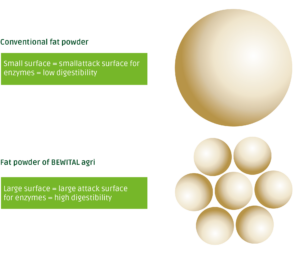
Here's something else that may interest you:
-
Keeping dairy cows healthy during lactation – with BEWI-FATRIX® CX
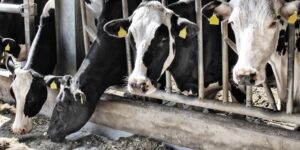
At the Hinnemann dairy farm in Germany, the use of BEWI-FATRIX® CX showed significant improvements in the metabolism of high-yielding dairy cows. The farm, which is known for its commitment to optimal animal health and high performance, uses BEWI-FATRIX® CX to effectively manage the challenges of lactation.
learn more -
BEWI-LACTO+® Amino LM: Positive effect on milk yield and metabolism

BEWI-LACTO+® Amino LM promises success in high-performance herds and has a positive effect on the milk yield and metabolism of the cows. Christoph Eberhardt and Daniel Langer draw a positive conclusion. Due to the good results, they plan to continue using amino acids in the ration in the future.
learn more -
Not all fats are the same

When using rumen-stable fats, it is important to know their special properties. Because: not all fats are the same! Products on the market differ significantly in terms of the fatty acid pattern, the manufacturing process and thus also in terms of rumen stability and digestibility. The right mix of C16:0 and C18:0 makes it work
learn more
